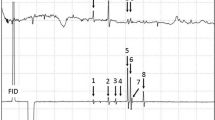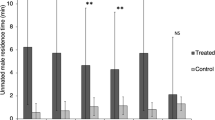Abstract
Eleven out of 13 disruption profiles (plots of dispenser density vs. male catch) from moth sex pheromone literature were consistent with a competitive-attraction mechanism, in which dispensers attract males and thereby divert them from females. Mean dispenser activity (D a) across all competitive-attraction cases was 0.04 ± 0.06 (SD); values ranged from 0.0005 for a tiny laminated flake dispenser of racemic disparlure targeting gypsy moth to 0.2 for polyethylene tube dispensers used against lightbrown apple moth. A dispenser application activity (\(D_{{\overline{\rm A}\rm a}} \)) can be calculated by multiplying D a by the number of such dispensers applied per hectare of crop. The highest dispenser application activity (\(D_{{\overline{A} a}} \)) values approached 200 and corresponded to >99% inhibition of catches of male moths in monitoring traps. Relative to the \(D_{{\overline{A} a}} \) scale, % inhibition of catches of male moths compressed and obscured large differences in \(D_{{\overline{A} a}} \) when % disruption exceeded 90%. For cases of competitive attraction, these two efficacy scales can be interconverted by using the formula: \(D_{{\overline{A} a}} \approx {100} \mathord{\left/ {\vphantom {{100} {{\left( {100{\text{ }}{\text{ minus }}\% {\text{ disruption}}} \right)}}}} \right. \kern-\nulldelimiterspace} {{\left( {100{\text{ }}{\text{ minus }}\% {\text{ disruption}}} \right)}}\). When disruptive point sources of pheromone were directly observed, male moths were seen approaching pheromone dispensers whose disruption profiles matched competitive attraction. Two cases fit non-competitive disruption mechanisms, which include camouflage, desensitization (adaptation and/or habituation), and sensory imbalance. In these cases, pheromone was released at rates higher than for cases of disruption by competitive attraction. Practical ramifications of the finding that competitive attraction appears to be the prevalent mechanism for moth mating disruption by pheromone point sources are listed. We believe that the congruence of diverse sets of mating disruption field data with explicit a priori predictions validates competitive-attraction theory. The analytical tools and principles governing competitive attraction that were uncovered during this study of mating disruption of moths should be generally applicable to competitive-attraction phenomena.











Similar content being viewed by others
References
Atterholt, C. A. 1996. Controlled release of insect sex pheromones from sprayable, biodegradable materials for mating disruption. PhD dissertation, University of California, Davis, CA.
Atterholt, C. A., Delwiche, M. J., Rice, R. E., and Krocht, J. M. 1998. Study of biopolymers and paraffin as potential controlled-release carriers for insect pheromones. J. Agric. Food Chem. 46:4429–4434.
Baker, T. C., Cardé, R. T., and Miller, J. R. 1980. Oriental fruit moth pheromone component emission rates measured after collection by glass-surface adsorption. J. Chem. Ecol. 6:749–758.
Berkhead, T. R. 1998. Sperm Competition and Sexual Selection. Academic Press, San Diego, CA, USA.
Capinera, J. L. and Barbosa, P. 1975. Transmission of nuclear polyhedrosis virus to gypsy moth larvae by Calosoma sycophanta. Ann. Entomol. Soc. Am. 68:493–494.
Cardé, A. M., Baker, T. C., and Cardé, R. T. 1979. Identification of a four-component sex pheromone of the female oriental fruit moth, Grapholita molesta (Lepidoptera: Tortricidae). J. Chem. Ecol. 5:423–427.
Charlton, C. E. and Cardé, R. T. 1981. Comparing the effectiveness of sexual communication disruption in the oriental fruit moth (Grapholita molesta) using different combinations and dosages of its pheromone blend. J. Chem. Ecol. 7:501–508.
De Lame, F. M. 2003. Improving mating disruption programs for the oriental fruit moth, Grapholita molesta (Busck): efficacy of new wax-based formulations and effects of dispenser application height and density. M.S. thesis, Michigan State University, E. Lansing.
Deland, J. P., Judd, G. J. R., and Roitberg, B. D. 1994. Disruption of pheromone communication in three sympatric leafroller (Lepidoptera: Tortricidae) pests of apple in British Columbia. Environ. Entomol. 23:1084–1090.
Evenden, M. and MCLaughlin, J. R. 2004. Factors influencing the effectiveness of an attracticide formulation against the oriental fruit moth, Grapholita molesta. Entomol. Exp. Appl. 112:89–97.
Flint, H. M. and Merkle, J. R. 1983. Pink bollworm (Lepidoptera: Gelechidae): communication disruption by pheromone composition imbalance. J. Econ. Entomol. 76:40–46.
Giroux, P. Y. and Miller, J. R. 2001. Phytotoxicity of pheromonal chemicals to fruit tree foliage: chemical and physiological characterization. J. Econ. Entomol. 94:1170–1176.
Isaacs, R., Ulczynski, M., Wright, B., Gut, L. J., and Miller, J. R. 1999. Performance of the microsprayer, with application for pheromone-mediated control of insect pests. J. Econ. Entomol. 92:1157–1164.
Knight, A. L. 2003. Testing attracticide hollow-fiber formulations for control of codling moth, Cydia pomonella (Lepidoptera: Tortricidae). J. Entomol. Soc. Brit. Columbia 100:71–78.
Lawson, D. S., Reissig, W. H., Agnello, A. M., Nyrop, J. P., and Roelofs, W. L. 1996. Interference with the mate-finding communication system of the obliquebanded leafroller (Lepidoptera: Tortricidae) using synthetic sex pheromones. Environ. Entomol. 25:895–905.
Li, W., Scott, A. P., Siefkes, M., Yan, H., Liu, Q., Yun, S., and Gage, D. A. 2002. Bile acid secreted by male sea lamprey that acts as a sex pheromone. Science 296:138–141.
Mafra-Neto, A. and Baker, T. C. 1996. Timed, metered sprays of pheromone disrupt mating of Cauda cautella (Lepidoptera: Pyralidae). J. Agric. Entomol. 13:149–168.
McLaughlin, J. R., Shorey, H. H., Gaston, L. K., Kaae, R. S., and Stewart, F. D. 1972. Sex pheromones of Lepidoptera. XXXI. Disruption of sex pheromone communication in Pectinophora gossypiella with hexalure. Environ. Entomol. 1:645–650.
Miller, J. R. and Cowles, R. S. 1990. Stimulo-deterrent diversion: a concept and its possible application to onion maggot control. J. Chem. Ecol. 16:3197–3212.
Miller, J. R., Mori, K., and Roelofs, W. L. 1977. Gypsy moth field trapping and electroantennogram studies with pheromone enantiomers. J. Insect Physiol. 23:1447–1453.
Miller, J. R., Gut, L. J., De LAME, F. M, and Stelinski, L. L. 2006. Differentiation of competitive vs. non-competitive mechanisms mediating disruption of moth sexual communication by point sources of sex pheromone: (Part 1) Theory. J. Chem. Ecol., this issue.
Polavarapu, S., Wicki, M., Vogel, K., Lonieran, G., and Nielson, K. 2002. Disruption of sexual communication of oriental beetles (Coleoptera: Scarabaeidae) with microencapsulated formulation of sex pheromone components in blueberries and ornamental nurseries. Environ. Entomol. 31:1268–1275.
Rothschild, G. H. L. 1975. Control of oriental fruit moth (Cydia molesta) (Busck) (Lepidoptera: Tortricidae) with synthetic female pheromone. Bull. Entomol. Res. 65:473–490.
Shorey, H. H. and Gerber, R. G. 1996. Use of puffers for disruption of sex pheromone communication among navel orangeworm moths (Lepidoptera: Pyralidae) in almonds, pistachios, and walnuts. Environ. Entomol. 25:1154–1157.
Shorey, H. H., Summers, G. G., Sisk, C. B., and Gerber, R. G. 1994. Disruption of pheromone communication in Spodoptera exigua (Lepidoptera: Noctuidae) in tomatoes, alfalfa, and cotton. Environ. Entomol. 23:1529–1533.
Shorey, H. H., Sisk, C. B., and Gerber, R. G. 1996. Widely separated pheromone release sites for disruption of sex pheromone communication in two species of Lepidoptera. Environ. Entomol. 25:446–451.
Stelinski, L. L., Gut, L. J., Pierzchala, A. V., and Miller, J. R. 2004a. Field observations quantifying attraction of four tortricid moth species to high-dosage pheromone rope dispensers in untreated and pheromone-treated apple orchards. Entomol. Exp. Appl. 113:187–196.
Stelinski, L. L., Gut, L. J., Vogel, K. J., and Miller, J. R. 2004b. Behaviors of naïve and pheromone pre-exposed leafroller moths in plumes of high-dose pheromone dispensers in a sustained-flight wind tunnel: implications for pheromone-based mating disruption of these species. J. Insect Behav. 17:533–553.
Stelinski, L. L., Miller, J. R., and Gut, L. J. 2005a. Captures of two leafroller moth species in traps baited with varying dosages of pheromone lures or commercial mating-disruption dispensers in untreated and pheromone-treated orchard plots. Can. Entomol. 137:98–109.
Stelinski, L. L., Gut, L. J., Epstein, D., and Miller, J. R. 2005b. Attraction of four tortricid moth species to high dosage pheromone rope dispensers: observations implicating false plume following as an important factor in mating disruption. IOBC/WPRS Bull. 28:313–317.
Stelinski, L. L., Gut, L. J., Mallinger, R. E., Epstein, D., Reed, T. P., and Miller, J. R. 2005c. Small plot trials documenting effective mating disruption of significant populations of oriental fruit moth, Grapholita molesta (Busck), using high densities of wax-drop pheromone dispensers. J. Econ. Entomol. 1267–1274.
Suckling, D. M. and Angerelli, N. P. D. 1996. Point source distribution affects pheromone spike frequency and communication disruption of Epiphyas postvittana (Lepidoptera: Tortricidae). Environ. Entomol. 25:101–108.
Tcheslavskaia, K. S., Thorpe, K. W., Sharov, A. A., Leonard, D. S., Reardon, R. C., Mastro, V. C., Sellers, P., Brewster, C. C., and Roberts, E. A. 2005. Optimization of pheromone dose for gypsy moth (Lymantria: Lymantriidae) mating disruption. Entomol Exp. Appl. 115:355–361.
Webb, R. E., Tatman, K. M., Leonhardt, B. A., Plimmer, J. R., Boyd, V. K., Bystrak, P. G., Schwalbe, C. P., and Douglass, L. W. 1988. Effect of aerial application of racemic disparlure on male trap catch and female mating success of gypsy moth (Lepidoptera: Lymantriidae). J. Econ. Entomol. 81:268–273.
Witzgall, P., Bäckman, A. C., Svensson, M., Koch, U., Rama, F., El-Sayed, A., Brauchli, J., Arn, H., Bengtsson, J., and Löfqvist, J. 1999. Behavioral observations of codling moth, Cydia pomonella, in orchards permeated with synthetic pheromone. Biocontrol 44:211–237.
Acknowledgments
J.M. credits Professor Joseph Meier of Millersville University for teaching the benefits of analyzing data as a set so as to comprehend underlying relationships, rather than being satisfied with an ANOVA and assignments of statistical significance to pairs of means. Appreciation is expressed to Naomi Miller and to senior technician Piera Siegert for affording J.M. the many long periods with few interruptions necessary to produce this and the previous paper. Aspects of this work were financially supported by grants to J.M. and L.G. from the USDA Special Grants Program, Michigan State University Project GREEEN, and The Michigan Apple Commission.
Author information
Authors and Affiliations
Corresponding author
Rights and permissions
About this article
Cite this article
Miller, J.R., Gut, L.J., de Lame, F.M. et al. Differentiation of Competitive vs. Non-competitive Mechanisms Mediating Disruption of Moth Sexual Communication by Point Sources of Sex Pheromone (Part 2): Case Studies. J Chem Ecol 32, 2115–2143 (2006). https://doi.org/10.1007/s10886-006-9136-6
Received:
Revised:
Accepted:
Published:
Issue Date:
DOI: https://doi.org/10.1007/s10886-006-9136-6




